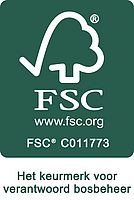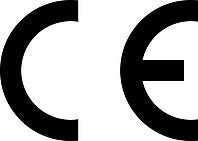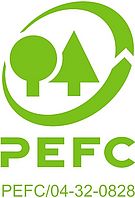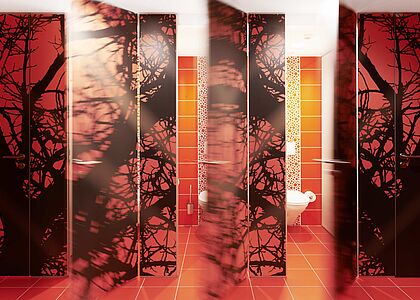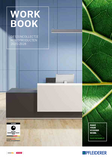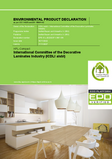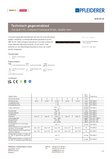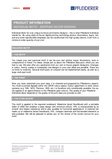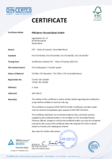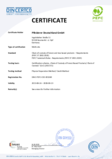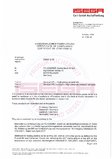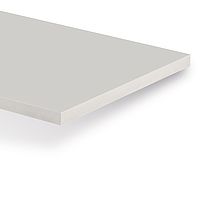Beschikbaarheid
Overzicht van beschikbare formaten
| Lengte (mm) | Breedte (mm) | Dikte (mm) | Structuur |
|---|---|---|---|
| 2.800 | 2.070 | 2 | 3 | 4 | 5 | 6 | 8 | 10 | 12 | 13 | 15 | HG | MP | SD | SM | VV |
Certificaten & labels
Eigenschappen
Toepassingsgebieden
- Individuele meubel- en inbouwelementen, in het bijzonder bij hoge eisen aan de robuustheid, onderhoudsvriendelijkheid en vochtbestendigheid van het materiaal. Maar ook wanneer geringe materiaaldoorsnedes of openrandoplossingen gerealiseerd moeten worden, bijv. in gastronomie, in de winkelbouw en de levensmiddelen gevoelige ruimtes, in praktijken en klinieken, wellness- en sanitaire ruimtes.
Productnorm
- Gebaseerd op EN 438-4
Basismateriaal
- Compacte kunststofplaat zwart: Homogeen zwart door-en-door gekleurde, massieve compacte kunststofkern, stootvast en vochtbestendig voor toepassingen met hoge belastingen.
Volumegewicht
- Min. 1.350 kg/m³
Brandgedrag
- Normaal ontvlambaar
- D-s2,d0 (EN 13501-1, CWFT volgens 2003/593/EG)
CE-categorie
- EN 438-7:2005
- Compacte panelen voor wand- en plafondbekleding (inclusief verlaagde plafonds)
Formaldehyde-emissieklasse
- E1 E05
Antimicrobiële werking
- Oppervlak met antimicrobiële effect binnen 24 uur voor interieurafwerking – Testmethode JIS Z 2801 / ISO 22196
Productveiligheid
- Dit product is in overeenstemming met de REACH-verordening EG 1907/2006 een fabricaat en dit fabricaat hoeft niet aan registratieplicht krachtens artikel 7 onderworpen te worden.
- Het oppervlak is fysiologisch gezien onschadelijk en toegestaan voor het contact met levensmiddelen (conform Verordening (EU) Nr. 10/2011).
- De decoratieve oppervlakken en de materiaalkern bestaan uit papierlagen, die met duroplastische harsen doordrenkt zijn.Deze harden tijdens het productieproces door hitte en hoge druk geheel uit. Ze bouwen een stabiele, resistente en niet reactief materiaal.
- Wij fabriceren het product zonder toevoeging van organische halogeenverbindingen, zware metalen, conserveringsmiddelen, houtbeschermingsmiddelen en organische oplosmiddelen.
Bijzonderheden
- Maximaal motief per plaat incl. overmaat 2.750 x 2.030 mm. Grotere motieven kunnen naast elkaar geplaatst worden.
- Levering van op maat gezaagde delen niet mogelijk.
- Bij herdrukken kunnen kleurafwijkingen optreden.
- Maximaal motief per plaat incl. overmaat 2.750 x 2.030 mm. Grotere motieven kunnen naast elkaar geplaatst worden.
- Levering standaard zonder beschermfolie.
- Levering van op maat gezaagde delen niet mogelijk.
- FSC-certificering of PEFC-certificering – Op aanvraag verkrijgbaar.
Kleuren en oppervlakken passen bij elkaar
- Decor, structuur en drager beïnvloeden het uiteindelijke uiterlijk van het eindproduct.
- Door de productspecifieke verschillen in productietechnologieën, zelfs identieke decor/structuur/basiscombinaties binnen of met verschillende productgroepen en formaten tot lichte optische en haptische afwijkingen. Dergelijke afwijkingen vormen geen gebrek.
- Vooral de keuze van de oppervlakstructuur heeft een belangrijke invloed op de visuele indruk, de haptische perceptie en de technische kenmerken van het product. Zo kan de algemene indruk van een decor bijna volledig veranderen afhankelijk van de oppervlakstructuur. Bovendien kunnen mechanische invloeden op het productoppervlak leiden tot een hoger contrasterende optische waarneming met donkere decors.
- Om ervoor te zorgen dat u altijd het beste resultaat behaalt met onze producten en om eventuele afwijkingen vooraf op te helderen, adviseren wij u graag individueel.
Aanvullende informatie
Behandeling
Verwerking
- Merk op, dat laminaten met digitale druk op basis van hun materiaalsamenstelling wat harder en droger zijn dan klassieke laminaten.
- Indien mogelijk wordt ieder motief standaard rondom geproduceerd met een overmaat van ongeveer 15 mm en overeenkomstig ingesteld snijtekens.
- De snijlijnen van het motief zijn niet bindend, voor het op maat snijden moet daarom elk motiefformaat worden gecontroleerd.
- Het is niet mogelijk om de panelen in een stapel te zagen of te formatteren.
- Het motief parallel aan de plaatzijde afdrukken is uit productietechnische gronden niet mogelijk.
- Vóór de verwerking en montage is een goede conditionering noodzakelijk. De ruimten zelf moeten daarbij overeenkomstig het latere gebruik geklimatiseerd worden.
- Voor een optimaal resultaat bij het op maat zagen raden wij de volgende maatregelen aan:
- gebruik van een wisseltandzaagblad met afschuining (WZ/FA), bv. GlossCut-zaagblad van de firma Leitz
- ook bruikbaar zijn holle tand- of trapeziumtand-zaagbladen met negatieve tandhoek
- geoptimaliseerde hoogteinstelling van het zaagblad
- universeel voorzaagblad gebruiken
- overmatig trillen van het materiaal bv. door middel van drukbalk of aandrukstrip voorkomen
- met lagere toeren werken dan bij standaard laminaten - Bij het zagen en boren moet met een vlakke, stevige ondergrond worden gewerkt.
- Houd er rekening mee dat scherpe snijkanten en een rustige loop van de gereedschappen absoluut noodzakelijk zijn voor goede resultaten.
- Boorgaten moeten opgeboord worden. Doorgangsboringen moeten met een overmaat worden uitgevoerd.
- Uitsnijdingen en binnenhoeken moeten een straal van min. 8 mm hebben, om kerfspanningen en daarmee een eventuele latere scheurvorming te vermijden.
- Om gekartelde kanten te vermijden, zijn freesgereedschappen met hoge omloopsnelheid noodzakelijk. De toevoersnelheid moet in rand-, hoek- en snijpuntgebieden verlaagd worden.
- Het polijsten van de smalle vlakken is mogelijk:
1. droog schuren met korrel 120/220/400
2. nat schuren met korrel 600/1000/1500/2000
3. polijsten met vilten schijf (korrel 600) en polijstpasta - Neem voor de verwerking van HPL-compactplaten de aanbevelingen van de branchevereniging ICDLI in acht (www.ICDLI.com).
- Wij raden aan om overeenkomstig het specifieke gebruik en de eisen aan het materiaal, zelftests uit te voeren.
Machine en gereedschap
- Met hardmetaal of met diamant ingezette gereedschappen op traditionele houtbewerkingsmachines bewerkbaar.
- Decoupeerzagen, stansen en zetbanken zijn niet geschikt.
Sluitwerktechnologie
- Alle traditionele verwijderbare en niet verwijderbare verbindingsstukken voor houtproducten zijn geschikt.
- Geschikt zijn alle conventionele meubelbeslag en standaard profielsystemen.
Inbouw en montage
- Vóór de montage moeten alle systeemelementen (wandbekledingselementen, draagconstructie) voldoende, gedurende meerdere dagen geconditioneerd worden. De ruimten zelf moeten daarbij overeenkomstig het latere gebruik geklimatiseerd worden.
- Het materiaal is niet geschikt voor toepassingen, die aan grotere klimaatschommelingen met betrekking tot de temperatuur en luchtvochtigheid zijn blootgesteld.
- Bij een ingebouwde toepassing moet voor een goede achterventilatie en een klimaatevenwicht aan beide zijden gezorgd worden.
- Voor voldoende luchtcirculatie moet de holle ruimte min. 20 mm bedragen.
- Het is belangrijk dat horizontaal lopende draagconstructies zoals de begin- en eindstukken van de wandbekleding zo onderbroken worden, dat een verticale achterventilatie mogelijk is.
De directe bevestiging op de ondergrond zonder luchtinlaat moet vermeden worden. - In principe moet er daarbij op gelet worden dat de uitzettings mogelijkheid van alle gemonteerde elementen niet belemmerd wordt. Bij een combinatie met andere materialen moeten de evt. verschillende uitzettingscoëfficiënten in acht worden genomen
- Er moet gezorgd worden voor voldoende bewegingsmogelijkheid van het plaatmateriaal in de ingebouwde toestand. Plaatnaden moeten met voegen en doorgangsboringen met overmaat worden uitgevoerd.
- Nieuwe wanden (gemetseld, van beton of bepleisterd) bevatten aanzienlijke hoeveelheden vocht en moeten volledig droog zijn vóór de bekleding.
- De ondergrond mag niet vochtig of instabiel zijn. Er moet op gelet worden dat het minimum draagvermogen en de minimum stabiliteit voor het desbetreffende gebruik aanwezig zijn.
- De draagconstructie moet tegen corrosie beschermd worden.
- Vermijd directe hitte en daaruit eventueel voortvloeiende uitdroging van HPL-platen door licht- of warmtestraling, bijv.luchtstromen van verwarmings- of klimaatsystemen.
- Let op een vakkundige verwerking en montage volgens de actuele stand van de techniek.
- Voor aanvullende informatie verwijzen wij u naar de merkbladen van de ICDLI-branchevereniging voor de verwerking en montage van laminaten en compact laminaten. (www.ICDLI.com)
Opslag, gebruik en transport
- De opslag moet steeds over het gehele oppervlak, gelijkmatig met de randen en horizontaal op een vlakke en schone onderlaag onder normale binnenomstandigheden (temperatuur 18–25°C, relatieve luchtvochtigheid 50–65%) plaatsvinden.
- De opslag in de directe omgeving van doorgangsdeuren, bv. in het gebied van laad- en loszones moet vermeden worden.
- Beschermen tegen luchtvochtigheid en vochtinwerking.
- Vermijd directe hitte en daaruit eventueel voortvloeiende uitdroging van HPL-platen door licht- of warmtestraling, bijv.luchtstromen van verwarmings- of klimaatsystemen.
- Directe zonnestraling of UV-stralen moeten met name bij producten met folie vermeden worden.
- De opslag moet steeds over het gehele oppervlak, gelijkmatig met de randen en horizontaal op een vlakke en schone onderlaag plaatsvinden, die met een kunststof folie is afgedekt. De bovenste plaat moet ook met folie en met een afdekplaat over het gehele oppervlak worden afgedekt.
- Deze opslagcondities moeten na iedere onttrekking uit de stapel gegarandeerd worden.
- Een verticale opslag wordt niet aanbevolen.
- Houd er rekening mee dat iedere onvakkundige opslag, onafhankelijk van de duur ervan, onomkeerbare vervorming kan veroorzaken.
- Vreemde voorwerpen en schurende verontreinigingen in de stapel platen kunnen leiden tot indrukkingen en beschadigingen van het oppervlak.
- De platen mogen niet tegen elkaar verschoven en over elkaar getrokken worden, ze moeten met de hand of met zuignappen één voor één opgetild worden.
- Bij het transport van stapels platen moeten onderlagen gebruikt worden die groot genoeg en stabiel zijn, bv. pallets. De platen in de stapel moeten beveiligd zijn tegen wegglijden.
Arbeidsveiligheid en bescherming van de gezondheid
- Draag voor desbetreffende activiteit noodzakelijke persoonlijke beschermingsmiddelen (PBM).
Reiniging en verzorging
- De reiniging van het oppervlak kan met water en delicate reinigingsmiddelen gebeuren. Neem voor het verwijderen van hardnekkige verontreinigingen de adviezen in het gegevensblad „Cleaning of HPL surfaces“ (www.icdli.com) in acht.
- Bij de gebruikelijke reiniging is het afvegen van het oppervlak met water en een mild schoonmaakmiddel normaliter voldoende. Er kunnen ook oplosmiddelen, zoals bijv. terpentine, aceton of celluloseverdunner, worden gebruikt (bijv. voor het verwijderen van graffiti), omdat die het oppervlak niet aantasten.
Afstoting
- Terugwinning van energie in industriële brandinstallaties bij temperaturen boven 700 °C.
Wilt u meer weten?
Neem dan contact met ons op. Wij staan voor u klaar.




